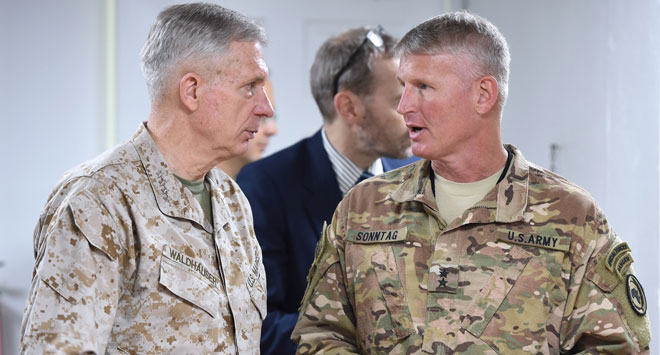
After six years, US troops end hunt for LRA warlord Kony
Libreville, Gabon | AFP | US special forces on Wednesday begin pulling out of Central African Republic where they deployed in 2011 to help hunt the brutal LRA warlord Joseph Kony.
The move, which was announced last month, will see US troops pulling out of the country’s east where they have been helping Ugandan forces track down rebels from the feared Lord’s Resistance Army (LRA).
“The time has come to move forward because the organisation itself is really in a survival mode,” General Thomas Waldhauser, head of the US military’s Africa Command (AFRICOM) said in a telephone briefing last week.
One of Africa’s longest-surviving rebel groups, the LRA has terrorised parts of central Africa for 30 years.
Several years ago it counted several thousand fighters but today has fewer than 100, with the rebels dispersed across parts of CAR, the Democratic Republic of Congo, Sudan and South Sudan.
Since it was set up by Kony in 1987, the LRA has slaughtered more than 100,000 people and abducted 60,000 children who were forced to become sex slaves and soldiers, UN figures show.
In 2011, Washington sent in around 100 US troops to eastern CAR to help regional forces hunt down Kony, adding another 150 special forces airmen three years later.
But last month, AFRICOM said it would be wrapping up the operation, which has cost between $600 and $800 million, even though Kony remains at large.
– ‘Significant success’ –
“This operation was a significant success,” Jeffrey Hawkins, the US envoy to CAR, told France’s RFI radio in early April.
Ugandan troops, who have been in eastern CAR since 2009, are also withdrawing from the area.
Last week, the army said the mission to neutralise the LRA had been “successfully achieved” and that Kony “no longer poses any significant threat” to Uganda’s national security.
Although his power is much diminished, Kony — who combines religious mysticism with guerrilla tactics and a grim reputation for kidnapping and mutilation — remains at large.
According to Paul Ronan of the US-based advocacy group Invisible Children, which was behind an explosive 2012 video highlighting Kony’s atrocities and calling for his capture, the warlord is believed to be either in Sudan or CAR.
A self-styled prophet, Kony launched his bloody rebellion in a bid to overthrow the Ugandan government and impose a regime based on his own version of the Ten Commandments.
He is wanted by the International Criminal Court (ICC) in The Hague for war crimes and crimes against humanity, where one of his commanders, Dominic Ongwen, is currently on trial.
– ‘Why do we care?’ –
Earlier this year, questions appeared to arise over the level of US commitment to its various operations in Africa in the form of a set of questions posed by the transition team of incoming president Donald Trump to the State Department.
“The LRA has never attacked US interests, why do we care? Is it worth the huge cash outlays? I hear that even the Ugandans are looking to stop searching for him, since they no longer view him as a threat, so why do we?” said the document, a copy of which was obtained by The New York Times.
And last month, AFRICOM’s Waldhauser confirmed the operations were drawing to a close, saying there were only about 100 LRA rebels and that the mission had “essentially taken that group off the battlefield.”
– Fears in the east –
“Everywhere, in cafes, people are talking about the departure of the Ugandan and American troops,” a resident of Obo, a town in CAR’s southwest, told AFP by phone.
On April 17, around 6,000 people in the town took to the streets to demand that both sets of troops stay in place until they can be replaced by Central African forces.
Although there are UN peacekeeping forces from its MINUSCA mission in Central Africa, very few of them are present in the east of the country.
“This withdrawal will lead to a renewal of LRA attacks in the southeast,” warned Thierry Vircoulon, a specialist on central Africa at IFRI, the French institute for international relations.
“Nobody is under any illusion that the Central African troops which are to be sent there to avoid a security vacuum will be able to neutralise the LRA.”
As well as the threat from Kony’s militia, the eastern region is also struggling with attacks by other “armed groups”, regional police chief Ghislain Dieu-Benit Kolengo told AFP.
He was referring to rebels from the mainly Muslim ex-Seleka militia and from the Union for Peace in the Central African Republic (UPC), a splinter group from a rebel force in neighbouring Chad which rights groups say executed 32 civilians and captive fighters late last year.
“Even though we are officially ending the so-called counter-LRA mission, we are certainly aware of the fact that we don’t want to leave a void there,” said Waldhauser.
And he said Washington would continue to offer support to African troops in the form of both “training” and “intelligence”.
 The Independent Uganda: You get the Truth we Pay the Price
The Independent Uganda: You get the Truth we Pay the Price




When was the last time LRA conducted an operation in Uganda?
It is only someone ignorant who can say LRA has never attacked US interests. The Museveni government is an extension of US interests. It performs a lot of activities on behalf of the US government. It did alot in Rwanda and the Congo. It has been doing the fighting in Somalia on behalf of the US government etc.